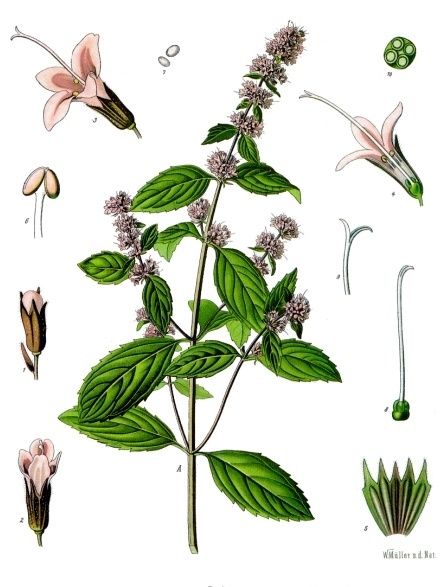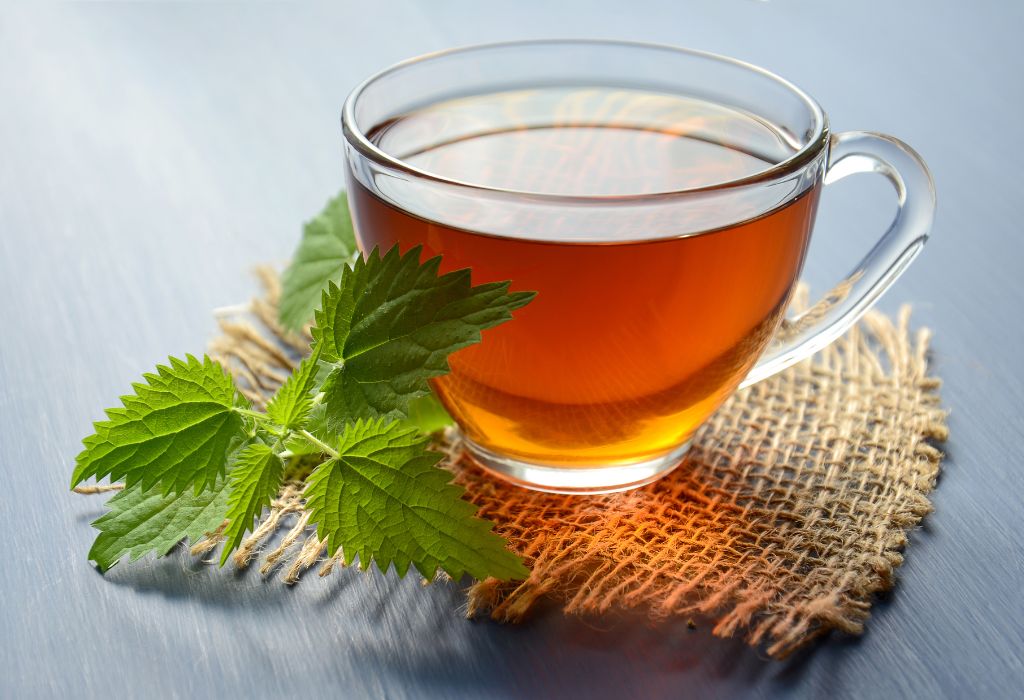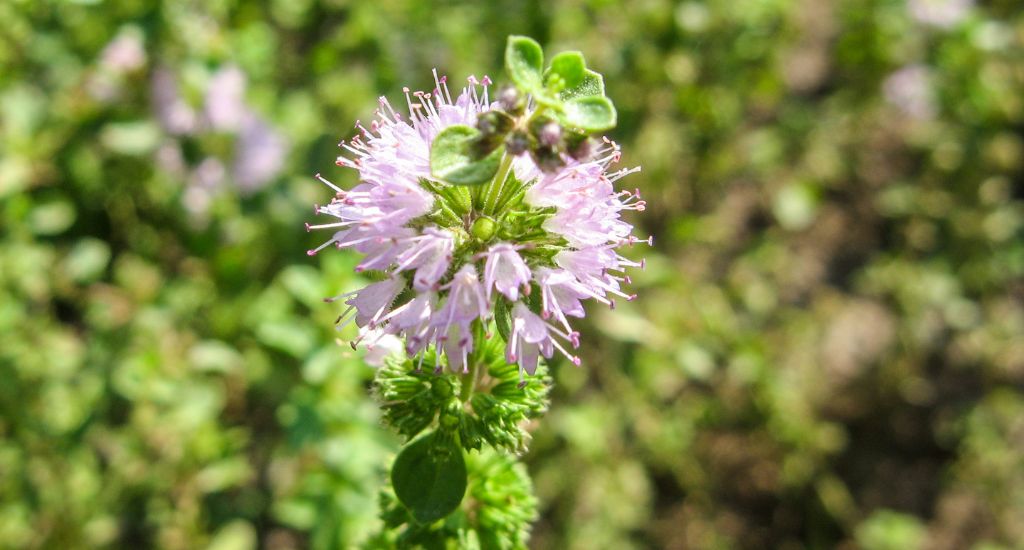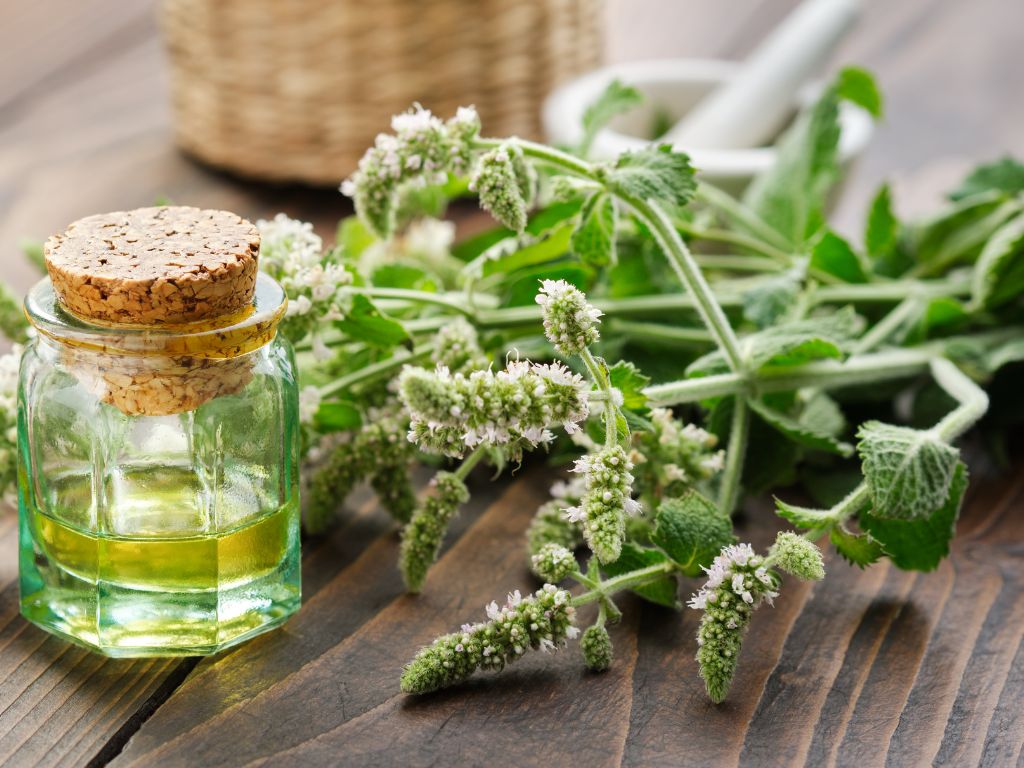Peppermint (Mentha × Piperita) is a hybrid mint species from the Lamiaceae family, derived from the crossbreeding of watermint and spearmint. The plant is indigenous to Europe and the Middle East, now widely dispersed and cultivated in various regions across the globe. It can occasionally be found in the wild alongside its parental species.
Peppermint is a plant of approximately 80cm in height, with branching stems, shiny lance-shaped, pointed, coarsely serrated, oppositely arranged leaves. Possessing a potent scent, its taste is hot and cooling. Owing to the blue veins, particularly in spring, the leaves appear dark, leading to the finest variety being referred to as “black mint”. Crimson red, occasionally white, flowers emerge from nodes in whorls, forming spike-like inflorescences. The fruit is a four-part nutlet, each with a seed.
Taxonomy
| Kingdom: | Plantae |
| Order: | Lamiales |
| Family: | Lamiaceae |
| Genus: | Mentha |
| Species: | Mentha × piperita |
Other names: Mint…
Blooming period
| I | II | III | IV | V | VI |
| VII | VIII | IX | X | XI | XII |
The Composition of Peppermint
Peppermint contains iron, an essential oil with 50-90% menthol, up to 20% menthone, then pinene, phellandrene, and limonene.
Peppermint Harvesting Period
Flowering from June to August, it is harvested during the blooming period. Both the leaves and young shoots with flower buds are utilized. The leaves carry a pleasant and aromatic scent and taste. Peppermint closely resembles wild basil (Calamintha officinalis), it’s essential to learn how to distinguish them to prevent confusion during harvest.
Mint tea benefits
Mint (Mentha x piperita) is a plant whose use alleviates various health issues. This aromatic herb is commonly used as a tea for digestive disorders, bowel cramps, gallbladder, and kidney colic. It can also be used externally, as an additive to baths, or as stuffing for sleep pillows. Mint is a remarkable natural remedy for migraines, headaches, itching, and rheumatism.
Preparation and Consumption of Peppermint Tea
To prepare peppermint tea, it is advisable to steep one tablespoon of peppermint leaves in 200 ml of boiling water. Afterward, cover the tea and allow it to infuse for around 30 minutes before straining. You can consume the tea without sweeteners before meals or sweeten it with honey after meals.
It is important to remember that boiling or rubbing mint should be avoided to preserve the beneficial properties of the essential oil found in the leaf glands. Additionally, peppermint should be stored in a dry, dark, and cool location to retain its freshness and medicinal properties.
Peppermint Medicinal Uses – Preparation, Application, and Effect
Peppermint, a versatile herb, boasts a wide array of applications in natural remedies. Its healing properties aid in alleviating digestive issues, soothing the nervous system, and easing cold symptoms. The following paragraphs further elaborate on this herb’s diverse applications.
Peppermint for Digestive Disturbances
For cases of diarrhea and digestive ailments, it is advisable to consider peppermint and chamomile tea. The brewing of this tea involves steeping three large tablespoons of a 50-50 mix of mint leaves and chamomile flowers in half a liter of boiling water. After a two-hour rest, enjoy this tea without sweeteners before meals or with a touch of honey afterwards. This tea is also suitable for children.
Peppermint for Calming and Balancing
Mint proves beneficial when seeking tranquility or relieving pregnancy-induced nausea and vomiting. To accomplish this, it is advisable to brew a tea by combining mint and lemon balm. For this blend, steep two tablespoons in 2.5 deciliters of boiling water, cover it, and let it rest for half an hour before straining.
To experience the soothing benefits, drink this infusion three times daily, one cup per serving. Additionally, mint can aid in relieving urinary discomfort. To address this concern, prepare a blend of peppermint, parsley, horsetail, and buckthorn bark by steeping them overnight in half a liter of boiling water. This resulting tea can serve as a substitute for water.
Peppermint for Heart Conditions and Nervous Tension
When heart conditions correlate with digestive issues, it’s suggested to prepare a tea from a mixture of peppermint, lemon balm, chamomile, fennel, caraway, yarrow, hawthorn flower, and buckthorn bark. This blend should be steeped in half a litre of boiling water, left to rest for half an hour, and then strained. Consumption of one cup of this tea post-meal is advisable.
Peppermint for Nervousness and Mood Soothing
For cases of nervousness, hypochondria, and similar conditions, consider using mint. It proves helpful when used in a tea blend of peppermint, bitter clover, valerian, lemon balm, and lavender. Steep this mix in boiling water for half an hour, strain, and enjoy one cup in the morning and evening. Unsweetened, it’s perfect before meals, while a touch of honey adds a sweet note afterwards.
Additionally, peppermint has nerve-calming and strengthening effects. A recipe involves boiling mint with honey in water or steeping it in white wine and water. Consume a cup every morning and evening, and take an extra tablespoon every one to two hours throughout the day.
Peppermint for Insomnia and Nervous Headaches
When dealing with insomnia and nervous headaches, it is advisable to prepare a tea using a combination of hops, peppermint, and lemon balm. To make this tea, steep three tablespoons of the blend in half a liter of boiling water, cover it, and strain it after two hours. For optimal results, consume one cup of this tea in the morning and one cup in the evening, without any sweeteners before meals, and sweeten it with honey after meals. Additionally, to alleviate insomnia, it is recommended to drink a bedtime tea consisting of peppermint and valerian.
Peppermint for Menstrual Cycle Regulation
Mint may serve as a beneficial aid in addressing menstrual cycle disturbances. A specially prepared tea, combining peppermint, valerian, chamomile, yarrow, and marigold flowers, is often recommended. Brew four tablespoons of this blend with 750 milliliters of boiling water, let it steep for half an hour, then strain. This warm tea can be consumed throughout the day.
Mint for Strengthening the Body in Anemia
For issues related to anemia or blood deficiency, it’s recommended to take a fresh peppermint plant juice blended with honey and Icelandic moss powder. Take two to three large spoons of this concoction daily for three to four weeks. This will help to strengthen the body.
Peppermint Oil: An Effective Deterrent Against Bugs
Peppermint oil is not only known for its aromatic and soothing qualities but also its potent bug-repelling properties. Insects, including ants, spiders, and even mosquitoes, find the strong scent of peppermint oil offensive, making it an excellent natural deterrent.
A mixture of water and a few drops of peppermint oil sprayed around your home can help to keep these unwanted visitors at bay. So, if you’re looking for a non-toxic, environmentally-friendly alternative to traditional pesticides, peppermint oil for bugs could be the solution you need.
Peppermint for External Application and Body Relaxation
Mint offers versatility in its applications, including steaming, bathing, and poultices. For a decoction, combine one kilogram of peppermint with four liters of water. This mixture can be used externally for steaming, bathing, and poultices. To create a peppermint decoction, simply boil one kilogram of peppermint in four liters of water. This liquid is ideal for soothing and invigorating steams, as well as a refreshing addition to baths. Additionally, it can be used as a poultice to alleviate bodily aches and reduce inflammation.
Various Types of Mint and Their Uses
In addition to peppermint, other types of mint are used for their medicinal properties. Curled mint (Mentha crispa) and water mint (Mentha aquatica) are among these varieties. Curled mint, found in Vojvodina, has a strong, aromatic scent. Water mint, on the other hand, grows alongside water streams and reaches a height of about 70 centimeters. Due to its stronger scent and taste, water mint is suggested for heart palpitations and frequent vomiting.
There’s also the pennyroyal mint (Mentha pulegium) that thrives near rivers on flooded terrains. The flowers of this mint variety are purple and exude a potent scent. Pennyroyal mint contains tannin, essential oil, and pulegone ketone, which is used in menthol production. This type of mint is utilized in the treatment of respiratory issues, bloating, common cold, and influenza.




